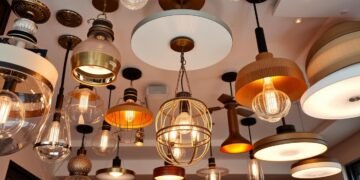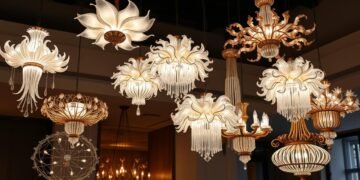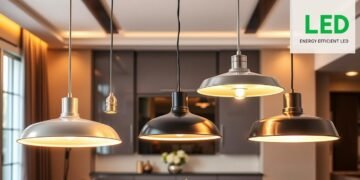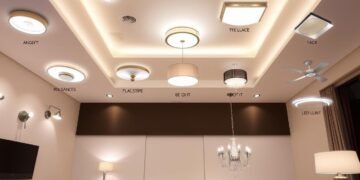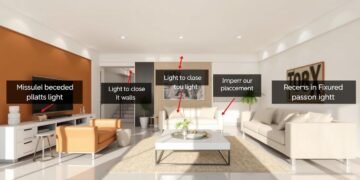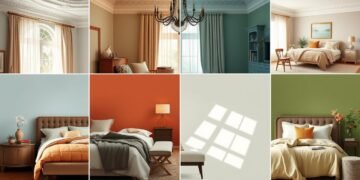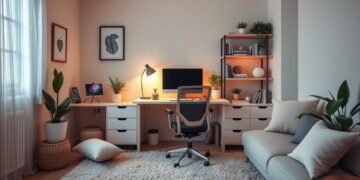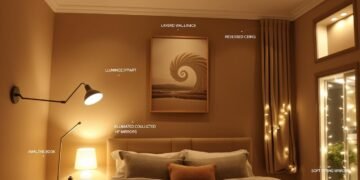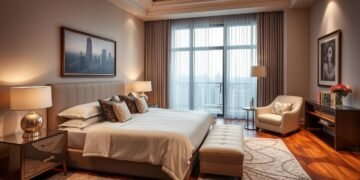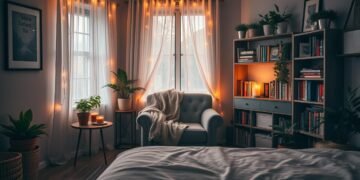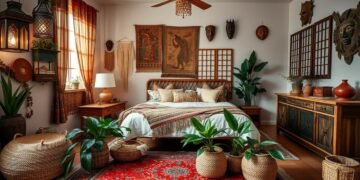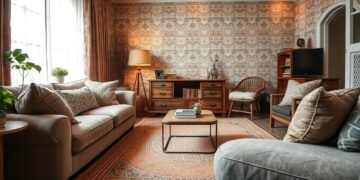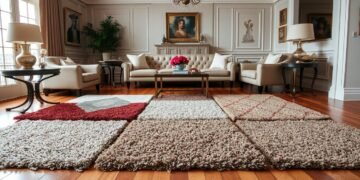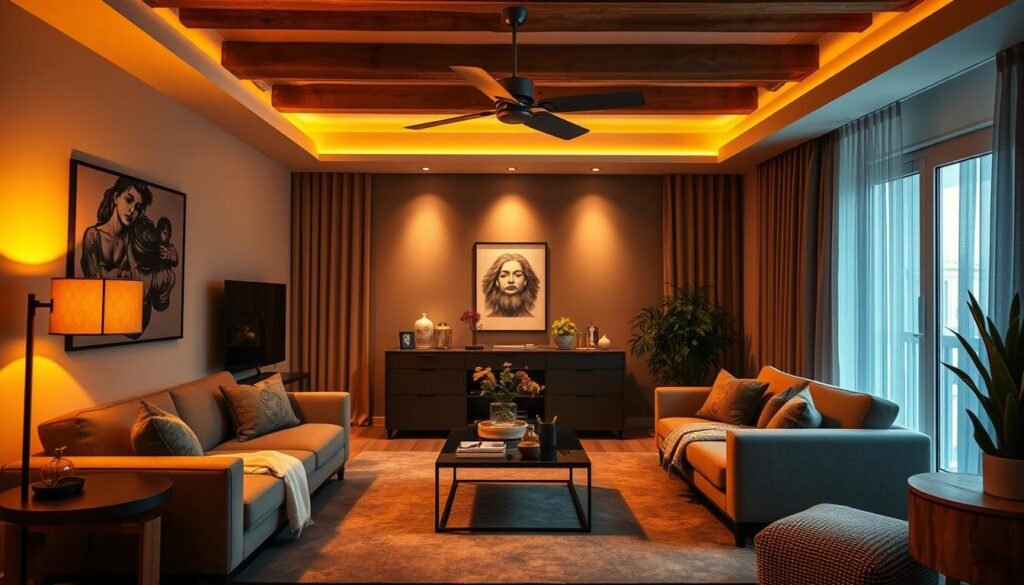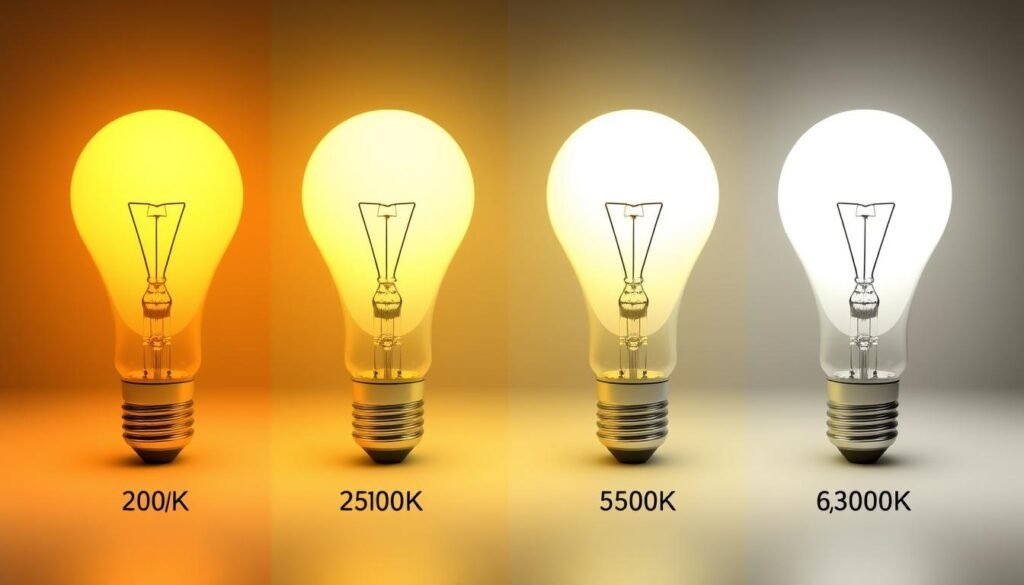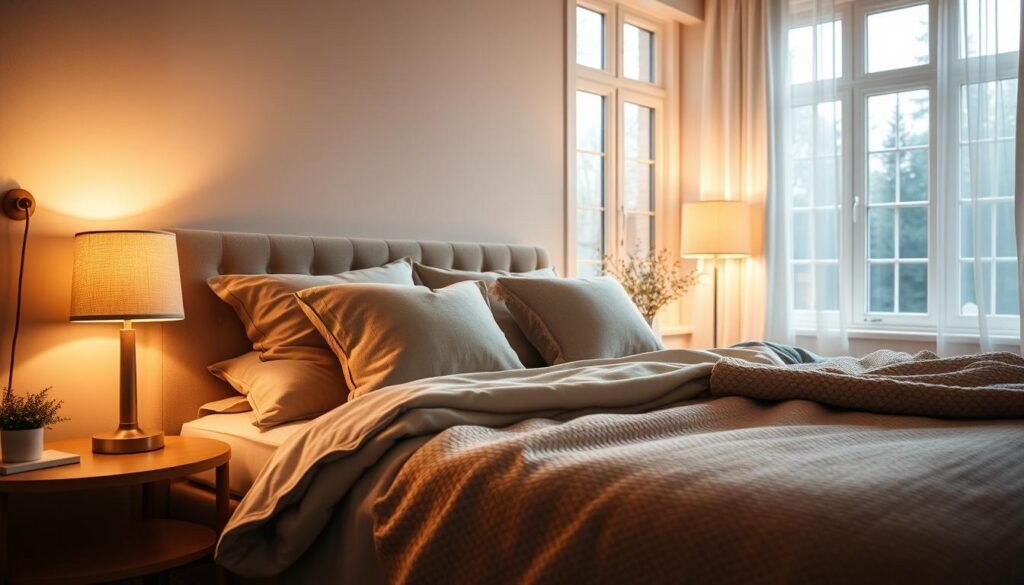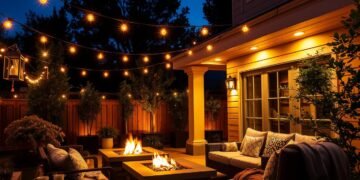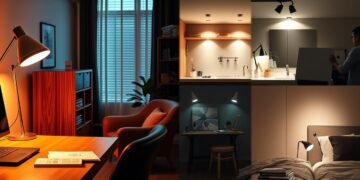“The only way to do great work is to love what you do.” – Steve Jobs
Choosing the right light bulb color temperature is key to the perfect home ambiance. The color temperature, measured in Kelvins (K), greatly affects the mood and function of each room. By grasping the Kelvin scale and its impact on light, you can turn your home into a welcoming, productive, and beautiful space.
Table of Contents
- 1 Understanding Light Bulb Color Temperature
- 1.1 The Science Behind Color Temperature
- 1.2 How Color Temperature is Measured in Kelvins
- 1.3 Relatedarticles
- 1.4 7 Sustainable Lighting Options for an Eco-Friendly Home
- 1.5 6 Ideas for Outdoor & Patio Lighting to Extend Your Living Space
- 1.6 7 Methods to Incorporate Task Lighting for Greater Functionality
- 1.7 The Impact on Room Ambiance
- 2 Benefits of Modern LED Lighting Solutions
- 3 The Kelvin Scale: From Warm to Cool Light
- 4 Room-Specific Lighting Requirements
- 5 Essential Lighting Terms: Watts, Lumens, and CRI
- 6 Choosing Light Colors for Different Activities
- 7 The Role of Natural Light in Color Temperature Selection
- 8 Smart Lighting and Color Temperature Control
- 9 Common Mistakes When Selecting Light Bulb Colors
- 10 Creating Layered Lighting Design
- 11 Conclusion
- 12 FAQ
- 12.1 What is light bulb color temperature and why is it important?
- 12.2 How does LED lighting compare to traditional bulbs in terms of color temperature options?
- 12.3 What is the Kelvin scale and how does it relate to light bulb color temperature?
- 12.4 How does light bulb color temperature affect room ambiance and functionality?
- 12.5 What are the key considerations when choosing the right color temperature for different rooms in my home?
- 12.6 What are the important lighting terms I should understand when selecting bulbs?
- 12.7 How does natural light influence the selection of artificial lighting color temperature?
- 12.8 What are the benefits of using smart lighting systems with adjustable color temperature?
- 12.9 What are some common mistakes to avoid when selecting light bulb color temperature?
- 12.10 How can I create a balanced, functional, and aesthetically pleasing lighting design in my home?
- 13 Source Links
Key Takeaways
- Light bulb color temperature ranges from warm (2000K-3000K) to cool (4600K+) light
- Choosing the right color temperature enhances room ambiance and supports various activities
- LED bulbs offer energy-efficient and versatile color temperature options
- Understanding the Kelvin scale is essential for making smart lighting choices
- Layered lighting design with different color temperatures can create a cohesive look
Understanding Light Bulb Color Temperature
Lighting your home is all about the color temperature of your bulbs. It’s measured in Kelvins (K) and affects the mood of your space. The color temperature scale is like the color wheel, with warm colors like red and cool colors like blue.
The Science Behind Color Temperature
The correlated color temperature (CCT) scale was created in the 1950s. It shows the color of a light source. Warm, yellowish lights have lower Kelvin numbers, while cool, bluish lights have higher numbers.
How Color Temperature is Measured in Kelvins
The Kelvin scale helps measure the color rendering index (CRI) and color temperature. A candle’s light is around 1000K, while the sky is about 9000K. Most bulbs, including LEDs, fall in between.
The Impact on Room Ambiance
The color temperature of your lighting greatly affects a room’s mood. Warm light (2000K-3000K) makes spaces cozy, perfect for living rooms and bedrooms. Neutral white light (3100K-4500K) is bright and clean, great for offices. Cool light (4600K+) energizes spaces, ideal for kitchens and bathrooms.
Benefits of Modern LED Lighting Solutions
Energy-efficient LED lighting has changed how we light our homes. These bulbs beat traditional incandescent bulbs in many ways. They are a top pick for those wanting long-lasting and flexible lighting options.
LED bulbs are super efficient, using way less energy than incandescent bulbs. This means big savings on your electricity bill. In fact, LEDs are 75% more energy-efficient and last up to 25 times longer than incandescent bulbs.
LED bulbs are also small, making them great for creative lighting designs. They let you change up your home’s look and feel. Plus, they don’t get hot, making them safer than old bulbs.
LED lighting is also good for the planet. If everyone used them, it could save as much energy as 44 big power plants. This helps cut down on carbon emissions and supports green living.
| Feature | Incandescent Bulbs | LED Bulbs |
|---|---|---|
| Energy Efficiency | 90% of energy released as heat | Waste very little energy |
| Lifespan | 1,000 hours | 15-20 years with standard use |
| Color Temperature | Typically 2700K | Range from 1650K to 6000K |
| Color Rendering Index (CRI) | Typically 60-70 | High-quality LEDs have CRI of at least 80, sometimes 90 or higher |
In short, LED lighting is a game-changer. It’s energy-smart, lasts a long time, and offers cool design options. It’s a smart choice for anyone wanting to brighten up their home in a green way.
The Kelvin Scale: From Warm to Cool Light
The Kelvin scale helps us understand the warmth or coolness of white light. It ranges from 2000 degrees Kelvin (K) for candle light to daylight’s bright, bluish hues. Daylight usually falls between 5500K and 6500K.
Warm Light (2000K-3000K)
Lights in the 2000K-3000K range give off a warm, soft white or bright white glow. This is great for cozy, inviting spaces. It’s often used in living rooms, bedrooms, and other places for relaxation.
Neutral Light (3100K-4500K)
Neutral light in the 3100K-4500K range offers balanced, daylight bulbs-like light. It’s perfect for areas needing both task-oriented and relaxation, like kitchens, home offices, and dining rooms.
Cool Light (4600K+)
Cool light (4600K and above) has a very bright, bluish glow like natural daylight. This crisp, energizing lighting temperature is great for workspaces, workshops, and areas needing maximum visibility and focus.
Knowing the Kelvin scale and light color temperature is essential. It helps choose the right bulbs for your home. This ensures the perfect ambiance for every room and activity.
Room-Specific Lighting Requirements
Creating the perfect ambiance in your home starts with the right lighting. Each room has its own lighting needs. From the cozy bedroom to the bright kitchen, understanding the right bathroom lighting, kitchen lighting, living room lighting, and bedroom lighting is key. This can transform your spaces and improve your well-being.
Bathrooms: Bright Task Lighting, Soft Ambiance
Bathrooms need both task lighting and soft ambiance. For vanity lighting, choose bright, clear light (3000-4000K) for grooming. Then, add softer, warmer light (2400-3000K) for relaxing moments like bubble baths.
Kitchens: Layered Lighting for Versatility
Kitchens require bright, clear light (2700-3500K) for cooking and cleaning. Use a layered lighting approach. This includes overhead, under-cabinet, and task-focused lights for a versatile space.
Living Rooms: Warm and Welcoming
Living rooms should feel warm and inviting. Choose lighting in the 2400-3000K range for coziness. Mix floor, table lamps, and accent lighting for a layered, intimate feel.
Bedrooms: Calm and Relaxing
Your bedroom should be serene and relaxing. Use warm, soft lighting (2700-3000K) for lamps and overheads. This promotes rest and helps you sleep well.
Customizing lighting for each room can turn your home into a peaceful oasis. The right lighting affects mood, productivity, and well-being.
Essential Lighting Terms: Watts, Lumens, and CRI
Choosing the right light bulbs for your home means knowing the basics. Watts, lumens, and color rendering index (CRI) are key. They show how bright, how much energy they use, and how colors look.
Understanding Wattage vs. Lumens
Watts tell you how much energy a bulb uses. But, they don’t show how bright it is. Lumens, on the other hand, measure brightness. A 60-watt incandescent bulb has about 800 lumens. But, a 9-watt LED can also have 800 lumens, using less energy.
Color Rendering Index Explained
The Color Rendering Index (CRI) shows how well a light shows colors like natural daylight. For places like kitchens and art studios, look for bulbs with a CRI of 80 or more. These bulbs make colors look true.
Energy Efficiency Considerations
LED lighting solutions are very energy-efficient. They use up to 80% less energy than old bulbs. Choosing energy-efficient light bulbs saves money on electricity in the long run, even if they cost more at first.
| Metric | What it Measures | Best for |
|---|---|---|
| Watts | Energy Consumption | Comparing power usage |
| Lumens | Light Output | Measuring brightness |
| CRI | Color Accuracy | Ensuring true color representation |
“By 2030, experts forecast that 87% of all lighting worldwide will be LEDs.”
Choosing Light Colors for Different Activities
Lighting greatly affects a room’s mood and atmosphere. The color of your light bulbs is key. It can make a room cozy or energizing, depending on your needs.
For task lighting, like reading or working, choose cooler, brighter light. This range, 4000-6500K, boosts focus and clarity. On the other hand, warmer light, 2700-3000K, is ideal for ambient lighting and mood lighting. It creates a calm atmosphere for relaxing or entertainment.
For flexibility, consider dimmable bulbs or smart lighting. These allow you to change the light color easily. This way, you can switch from task lighting to a cozy, accent lighting mood as you wish.
| Light Color | Kelvin Range | Best For |
|---|---|---|
| Warm Light | 2700-3000K | Relaxation, Ambiance |
| Neutral Light | 3100-4500K | Balanced, Accurate Color Rendering |
| Cool Light | 4600K+ | Task-oriented, Enhancing Focus |
Choosing the right light colors can support your natural rhythms and sleep. By matching light colors to your activities, you create a space that meets your needs.
The Role of Natural Light in Color Temperature Selection
Daylight is key to setting our body clocks and keeping our circadian rhythms in check. Morning light, rich in blue, helps reset these cycles. When picking artificial lighting, think about how it fits with the natural white light we get during the day.
Balancing Artificial and Natural Light
Natural light synchronization can range from 4000K to 6500K or more. This depends on the time, weather, where you are, and the season. To make your lighting feel right, pick artificial lights that match these circadian rhythms. Use cool, bright lights in the morning and warm, soft lights at night. This helps keep your sleep-wake cycles healthy.
Time of Day Considerations
- 4000K light feels like early-morning or late-afternoon sunshine, giving a warm natural feel.
- Color temperatures of 5000K and up are like natural daylight, with the cool, bright tones of midday sun.
- LED lights that match natural light are best for those indoors a lot, helping keep circadian rhythms healthy.
By mixing artificial and natural light well, you can make a space that looks good and feels good. This is true for both your home and work area.
Smart Lighting and Color Temperature Control
The rise of smart bulbs has changed how we light our homes. These bulbs let you control color and brightness. You can set the mood for any activity or time of day.
With smart lighting, changing bulb colors is easy. You can do it with apps or voice commands. Some bulbs even change color like daylight, helping your body clock and sleep.
- Smart bulbs like the AiDot Linkind Matter Smart Light Bulb ($12.99) and the Philips Dimmable A19 Smart Wi-Fi Wiz Light Bulb ($10.99) offer color temperature control features.
- The Nanoleaf Essentials Matter BR30 Smart Bulb ($29.99) lets you choose from 2,700K to 6,500K. The Roku Smart Bulb SE Color ($7.88) goes from 1,800K to 6,500K.
- Apps like CoRE (now WebCore) let you control color for many smart bulbs. This gives you more options for your home’s lighting.
As tech gets better, we’ll see more lighting control features. Soon, you’ll be able to make your home’s atmosphere perfect with just a few taps. Start using smart lighting to change your home’s mood like never before.
Common Mistakes When Selecting Light Bulb Colors
Choosing the right light bulb color temperature is key to a room’s feel and function. Yet, many homeowners make mistakes that affect their design. Let’s look at two common errors and how to steer clear of them.
Overlooking Room Function
One big mistake is not thinking about what each room is for. What works in the bedroom might not in the kitchen. Warm light (2700K-3000K) is great for cozy living areas. On the other hand, cooler light (4000K+) is better for places where you need to focus, like workspaces or bathrooms.
Ignoring Fixture Compatibility
Another mistake is not checking if bulbs fit their fixtures. The wrong bulb can cause flickering or uneven light. Make sure dimmable bulbs work with your dimmer switches. Also, check the bulb’s size to fit your fixtures right.
By avoiding these mistakes and using key bulb selection tips, you can make your lighting work better. It will improve your home’s look and feel.
Creating Layered Lighting Design
Creating a beautiful and useful lighting design for your home needs careful thought. Layered lighting, which combines ambient lighting, task lighting, and accent lighting, is essential. It makes your space welcoming and flexible.
Ambient lighting is the base, giving overall light and setting the mood. It should be even and soft, making areas like living rooms cozy and bright.
Task lighting is key for specific tasks, letting you adjust light where needed, like desks or kitchen counters. Adjustable pendants or dimmable track lights work well here.
Accent lighting brings the last touch, focusing on special features or art. Wall sconces, picture lights, and downlights are great for this.
By mixing these lighting types, you get a design that looks good and works well. Think about each room’s size, shape, and use when picking lighting fixtures and colors. This ensures your lighting looks good together.
Layered lighting can change any room, from cozy living areas to busy home offices. Finding the right mix of ambient, task, and accent lighting makes your home’s lighting better. It improves both looks and function.
Conclusion
Choosing the right light bulb color temperature is key for a cozy and functional home. Knowing the Kelvin scale and how different colors affect a room can change its feel. LED technology is energy-efficient and can help you create the perfect lighting.
Whether you want a warm bedroom or a bright office, the right bulb makes a big difference. Think about the room’s purpose, the time of day, and the mood you want. With the right light bulb selection guide, home lighting tips, and energy-efficient lighting and LED technology, you can light up your space just right.
Lighting affects our mood, work, and happiness. By understanding color temperature and designing your lighting, you can make your home more comfortable and functional. This way, every room will meet your specific needs and tastes.
FAQ
What is light bulb color temperature and why is it important?
How does LED lighting compare to traditional bulbs in terms of color temperature options?
What is the Kelvin scale and how does it relate to light bulb color temperature?
How does light bulb color temperature affect room ambiance and functionality?
What are the key considerations when choosing the right color temperature for different rooms in my home?
What are the important lighting terms I should understand when selecting bulbs?
How does natural light influence the selection of artificial lighting color temperature?
What are the benefits of using smart lighting systems with adjustable color temperature?
What are some common mistakes to avoid when selecting light bulb color temperature?
How can I create a balanced, functional, and aesthetically pleasing lighting design in my home?
Source Links
- Light Color & Temperature Guide – Best Home Lighting | TCP
- 5 tips to help you pick the best lightbulb for your room
- How to Choose the Right Light Bulbs for Your Home I John Henry
- What is Lighting Color Temperature?
- Colour Temperature – What Does It Mean? | Lightbulbs Direct
- Learn About LED Lighting
- LED Lighting
- LED Light Color Temperature Guide The importance of lighting in interior design is considerable — attractive lighting helps create an inviting setting. When you’re choosing LED lighting | WAC Lighting
- Colour Temperature | Warmth and Coolness of Light Explained
- 101. The Kelvin Scale – Choosing The Right Color Temperature For Your LED Lighting
- How to Choose the Right Light Temperature for your Bulb or Fixture
- Guide To Color Temperature In The Home
- Which colour temperature for which room?
- Understanding LED Lighting Terms: Lumen, Wattage, and Color Temperature – OLAMLED
- Common Lighting Terms – The National Center for Appropriate Technology
- Choosing the Right Color Temperature
- How to Know Which Light Bulb Temperature to Choose
- Choosing the Right Color Temperature
- What color temperature best approximates natural sunshine?
- Smart Lighting – Turn on and set white level (color temperature)
- The Best Smart LED Light Bulbs for 2024
- Smart LED Bulbs | WIFI Enabled |
- Designer Trick : Light Temperature & Bulbs – Room for Tuesday
- the biggest mistake you’re making with lighting – and how to fix it
- Types of Lighting Mistakes To Avoid When Lighting Your Home
- Lighting for Multi-Functional Spaces | Crown Lighting Group
- Mastering Layered Lighting for Multifunctional Spaces – LED Lights Direct
- Light Layering: Why It’s Important and How to Incorporate It
- Everything You Need to Know about Light Bulb Color Temperature
- Choosing the Right Color Temperature
- Color Temperature Explained
